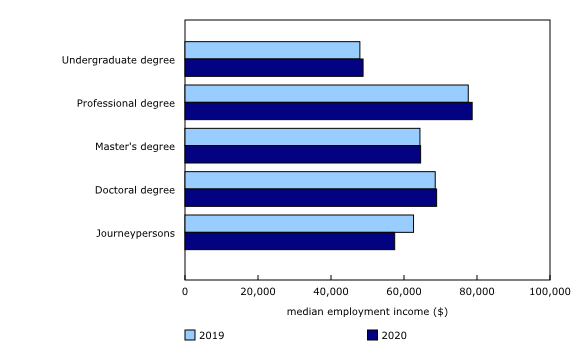StatCan: COVID-19 dragged down income for journeypersons
Those certified in 2020 earned a median income of $50,080.

A student practices welding at College of New Caledonia. – CNC
New data released by Statistics Canada is showing the impact the COVID-19 pandemic had on journeyperson careers.
The agency noted that the onset of the COVID-19 pandemic in 2020 had a negative impact on the economy as a whole, and on newly certified journeypersons in particular. This was seen in the take-up rates of the Canada Emergency Response Benefit among skilled tradespeople (38.4%) and the general working population (35.2%). Among the restrictions that provinces and territories implemented to contain the spread of COVID-19 was the closure of many worksites. Without the capacity to perform their jobs virtually, newly certified journeypersons were more affected than others in the labour force.
Journeyperson income dropped in 2020
Journeypersons who newly certified in 2020 earned a median employment income of $50,080 that year, which marked a 5.2% drop compared with what those who certified in 2019 earned. This also represented one of the lowest median employment incomes of newly certified journeypersons since the series started in 2008.
The median employment income of newly certified journeypersons continued to be highest in the territories (-13.5% to $66,540) and Alberta (-7.0% to $57,230). While both jurisdictions experienced significant drops, it was Newfoundland and Labrador (-16.3%) that recorded the largest decline from 2019.
Only 3 of the 31 trades saw growth in the median earnings of newly certified journeypersons from 2019 to 2020, namely agricultural equipment technicians (+9.8%), industrial instrumentation and control technicians (+4.4%) and powerline technicians (+1.1%). The remaining trades experienced decreases from 0.4% to 31.2%.

Trades that rely heavily on interactions with the public, such as hairstylists (-31.2%), cooks (-21.5%) and estheticians (-21.3%), decreased the most. The agency noted that because these three trades have some of the highest concentrations of female journeypersons and were most at risk of job disruption because of COVID-19 restrictions, their decreases contributed to a larger decline in female journeypersons’ income (-$3,780; -13.1%) than in male journeypersons’ income (-$3,190; -5.7%).
Across many trades, the median employment income of male and female journeypersons decreased by similar amounts, with a few exceptions. In the automotive service technician and welder trades, compared with 2019, the median employment income of newly certified female automotive service technicians (-$7,320; -18.1%) and welders (-$11,330; -19.8%) decreased more than that of male automotive service technicians (-$3,130; -6.8%) and welders (-$6,840; -11.9%). In contrast, although the median income of newly certified cooks (-21.5%) posted a large decrease compared with the previous cohort, the median income of male cooks (-$8,910; -24.4%) decreased more than that of female cooks (-$5,190; -16.8%).
Low mobility also recorded
In 2020, one year after certification, 5.2% of journeypersons either lived or worked in a province or territory other than their place of certification. This marked the lowest national mobility rate of journeypersons since the data series started in 2008, and a continued downward trend for a third year.
In 2020, against the backdrop of COVID-19 restrictions, weak oil prices, and declines in construction activity and support activities for oil and gas extraction (-41.3%), Alberta’s gross domestic product dropped 8.2%, the largest decline among the provinces and territories. Amidst these economic uncertainties, Alberta had difficulties retaining and attracting migrant journeypersons. In 2020, under one-fifth (18.2%) of mobile journeypersons (i.e., those who lived or worked in a province or territory other than their place of certification) who certified in 2019 moved to Alberta. This marked a 3.7 percentage point decline from the previous year and the sixth consecutive year of in-migration declines. In 2014, Alberta’s resource boom made it an attractive destination, and in-migration of newly certified journeypersons to Alberta peaked, with nearly one-half (48.9%) of mobile journeypersons moving there. In 2020, just over one-third (33.7%) of mobile journeypersons had left the province.
British Columbia slowly replaced Alberta as the most common destination for newly certified migrant journeypersons. In 2020, one year after certification, British Columbia received just under one-quarter (24.4%, +1.5% from 2019) of newly certified in-migrants, most of whom migrated from Alberta, followed by Ontario (22.6%), which also surpassed Alberta.
